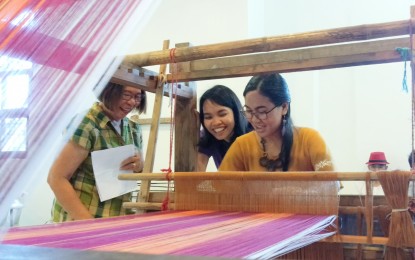
LOCAL TEXTILE. A museum-goer learns of 'hablon'-weaving at the National Museum in Western Visayas. Textiles made by the local weavers, with locally-grown materials, are assured of a wide domestic and global market. (PNA file photo by Gail Momblan)
ILOILO CITY -- Textile made in the Philippines will not run out of domestic and global markets, officials of the Department of Science and Technology-Philippine Textile Research Institute (DOST-PTRI) and the Great Women Philippines, Inc. (GWPI) said on Wednesday.
The two forces, with the Iloilo Science and Technology University and the local government of Miagao, Iloilo, have launched the Regional Yarn Production and Innovation Center (RYPIC) which will enable local weavers in Miagao to source their yarns from the town.
In an interview on Friday, DOST-PTRI director Celia Elumba said there is a demand in the textile made in the country, especially those which are made from locally-grown raw materials.
Filipinos here in the country and abroad are the primary market of textiles made by local weavers, Elumba said.
“We have a wide opportunity, in the domestic alone, if we can dress 10 percent (of the population), that would be fantastic. But aside from that, we look at Asean (Association of Southeast Asian Nations), which has 622 million (population),” she said.
Elumba said the country has a “preferential trade agreement” with Japan but the lack of materials in producing textiles cannot sustain the economic partnership.
The lack of local materials also poses as a challenge for the same trade agreement with Europe, she said.
“We are abundant when it comes to opportunities, but we need to go after the supply,” she said.
The RYPIC in Miagao town has 300 spindles to process blended yarns. In the country, Elumba said there are a total of 200,000 spindles.
GWPI president Jeannie Javelosa backed Elumba, saying Asean and Europe have a wide market for Philippine-made textiles.
Javelosa considers north Europe as the “real market” since they put value in the hand-woven, artisan-created textiles and women-made products.
She said the use of these local materials can help the Philippine-made textile compete with other textile-producing Southeast Asian countries.
“If we go into the market in Asean, we have to be strong with the blends, of the cotton, piña, maguey,” she said.
She added that there are many weaving communities in the country the GWPI is helping the weavers to become market-driven.
GWPI is a project of the Philippine Commission on Women to empower women in the economic environment, provide support to product design and market. (PNA)
